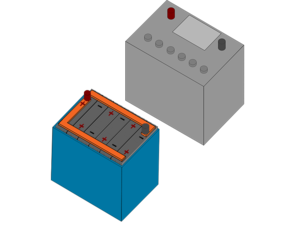Difference between revisions of "Lead acid battery"
| Line 11: | Line 11: | ||
This page will focus on deep-cycle batteries, which can be further divided into various categories. | This page will focus on deep-cycle batteries, which can be further divided into various categories. | ||
| + | |||
== Types == | == Types == | ||
Revision as of 19:14, 1 October 2020
Lead acid batteries rely on reversible chemical reactions between lead and acid to provide energy when it is needed and to store enegy when it is being produced. They have been around for over 150 years and have proven their durability, low-cost, recyclability, and performance under variable conditions to the point that nearly every automobile on the planet relies on a lead acid battery to start and run. Lead acid batteries have been the preferred form of energy storage for off-grid PV systems since they first began being built for the same reasons, thus most off-grid PV components are built for use with lead acid batteries in 12V, 24V or 48V configurations. Lead acid batteries have the added advantage of coming in a variety of voltages (2V, 6V, 12V) and amp-hour ratings (5Ah to 5000+Ah). But due to their high density of lead, this batteries are extremely heavy. A 225Ah flooded lead acid battery weighs around 60kg, which is approaching the upper-limit of what is easily movable without equipment.
Just like how a Solar PV module is comprised of various different PV cells connected together in series that each produce a certain voltage, lead acid batteries are composed of cells with each one producing around being having a nominal voltage of roughly 2V. This means that a 12V battery will be comprised of 6 cells.
There are many different types of lead acid batteries, but they can initially be divided into two categories: starter batteries and deep-cyle batteries.
- Starter batteries are used in cars and are intended to provide large amounts of power for short periods of time with a shallow depth of discharge. They work well for this purpose, but they are unable to continuously supply power beyond a shallow depth of discharge without severely shortening their cycle life. These batteries will fail prematurely in a PV system and are not worth investing in.
- Deep-cycle batteries have a more robust design that enables them to continuously supply high amounts of power to a deeper depth of discharge. These batteries are heavier and cost more than starter batteries, but are the appropriate battery for use with a PV system.
This page will focus on deep-cycle batteries, which can be further divided into various categories.
Contents
Types
Flooded lead acid
Characteristics
Projected life
Maintenance
Recyclability
Notes
https://www.trojanbattery.com/pdf/Signature_Trojan_ProductLineSheet.pdf https://www.trojanbattery.com/pdf/AGM_Trojan_ProductLineSheet.pdf https://www.trojanbattery.com/pdf/GEL_Trojan_ProductLineSheet.pdf
